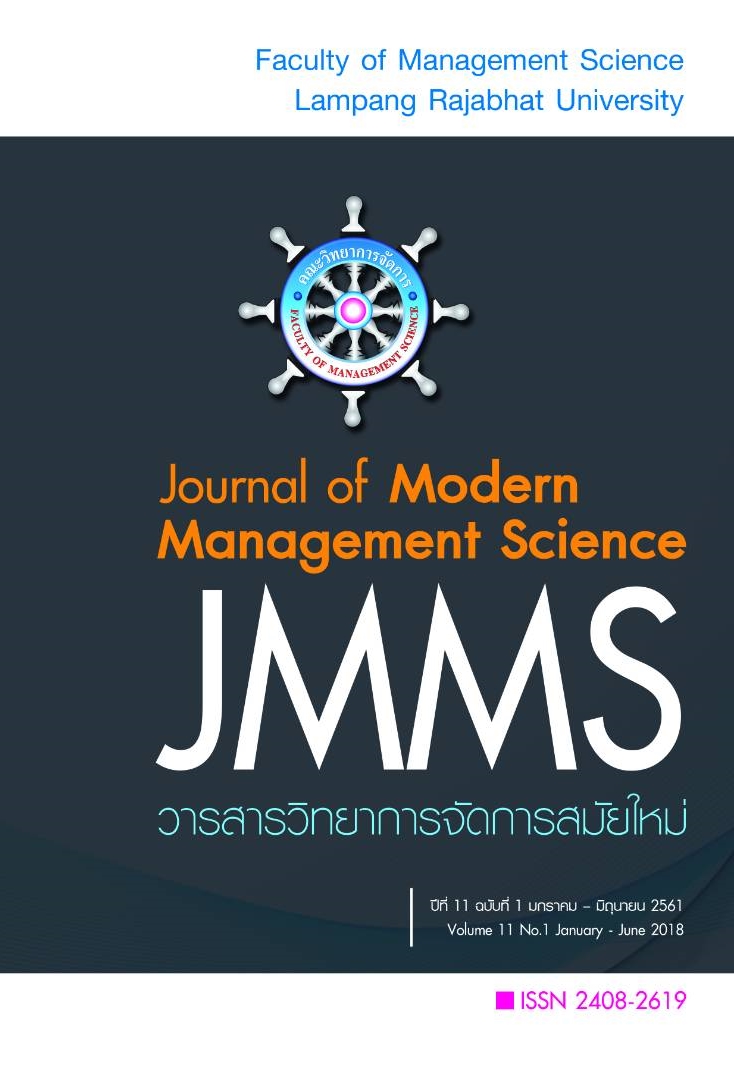The Administrative Model in the Office of Academic Resources and Information Technology, Rajabhat Universities
Main Article Content
Abstract
The purposes of this study were to develop the administrative model in The Office of Academic Resources and Information Technology, Rajabhat Universities. The research instruments consisted of a questionnaire, an interview form, and an assessment form. Data were analyzed using mean, standard deviation, and content analysis. The findings were as follows:
- The administrative model in The Office of Academic Resources and Information Technology, Rajabhat Universities. consisted of 3 elements and 1 successful condition as follows: The first element: Input consists of 2 parts: 1) Personnel, 2) The scope of work. The second element: Process consists of 7 steps: planning, organization, plan implementation, evaluation, improvement and development, reporting, and coordination. The third element: Output consists of two parts: 1) the efficiency of the self-assessment of The Office of Academic Resources and Information Technology, 2) the effectiveness of the customers’ satisfaction assessment of The administrative model in The Office of Academic Resources and Information Technology, Rajabhat Universities. The fourth element: Successful condition consists of four conditions: 1) University support, 2) Teamwork 3) Collaboration network, and 4) Executive’s vision.
2. The evaluation of the administrative model in The Office of Academic Resources and Information Technology, Rajabhat Universities, which was developed, has feasibility of implementation at the highest level with an average of 4.60.
Article Details
The article must be considered and accepted for publication by the editorial board of the Faculty of Management Science, Lampang Rajabhat University. The articles have been reviewed by a peer (peer review) and the author must update according to the suggestion if available before publication. Articles that are not considered the editorial team will inform the results of the consideration but will not send the original to the author.
JMMS is the Faculty of Management Science journal, Lampang Rajabhat University. Jmms published both print and online editions. We allow the use of articles for academic use under the scope of copyright law.
References
การสื่อสาร คณะมนุษยศาสตร์และสังคมศาสตร์ มหาวิทยาลัยขอนแก่น.
จันทรานี สงวนนาม. (2551). ทฤษฎีและแนวปฏิบัติในการบริหารสถานศึกษา. (พิมพ์ครั้งที่ 2). กรุงเทพฯ:
บุ๊ค พอยท์.
ณัฏฐญา เผือกผ่อง, ดวงใจ กาญจนศิลป์ และขวัญแก้ว เทพวิชิต. (2559). รายงานวิจัยสถาบันเรื่องความ
ต้องการและพฤติกรรมการใช้บริการศูนย์บรรณสารและสื่อการศึกษาของนักศึกษาต่างชาติ
มหาวิทยาลัยเทคโนโลยีสุรนารี. นครราชสีมา : ศูนย์บรรณสารและสื่อการศึกษา มหาวิทยาลัย
เทคโนโลยีสุรนารี.
น้ำทิพย์ วิภาวิน และยืน ภู่วรวรรณ. (2554). แนวโน้มการจัดการองค์การสารสนเทศ. ใน ประมวลสาระชุดวิชา การจัดการขั้นสูงสำหรับองค์การสารสนเทศ. หน้า 15-1 - 15-35. นนทบุรี: มหาวิทยาลัย สุโขทัยธรรมาธิราช.
นิภาพร ก๋าคำ และกัลย์ธีรา ทาเขียว. (2558). การประเมินความพึงพอใจของผู้ใช้บริการทรัพยากรสารสนเทศ
ของสำนักหอสมุด มหาวิทยาลัยแม่โจ้. เชียงใหม่ : มหาวิทยาลัยแม่โจ้.
บุษบา สุธีธร. (2554). การสื่อสารการตลาดในงานสารสนเทศ. ใน เอกสารการสอนชุดวิชาการสื่อสารในงาน สารสนเทศ หน่วยที่ 9-15 (ฉบับปรับปรุงครั้งที่ 2). (หน้า 10-1 –10-61). นนทบุรี:
มหาวิทยาลัยสุโขทัยธรรมาธิราช.
ปิยะนุช สุจิต. (2551, กรกฏาคม-ธันวาคม). เสริมสร้างสังคมความรู้เพื่อพัฒนานักศึกษาและเพิ่มพูนผลงานวิชาการ ของคณาจารย์. ใน วารสารห้องสมุด, 52(2).
ปิยวรรณ สิริประเสริฐศิลป์. (2553). การพัฒนารูปแบบการบริหารลูกค้าสัมพันธ์ของห้องสมุดสถาบันอุดมศึกษา
ไทย. ขอนแก่น: บัณฑิตวิทยาลัย มหาวิทยาลัยขอนแก่น.
พระราชบัญญัติมหาวิทยาลัยราชภัฏ พ.ศ. 2547. [ออนไลน์]. เข้าถึงได้จาก: http://regis.nsru.ac.th/know/1-
1.1-NSRU_AC-3.pdf. [2558, มกราคม 6].
ภาวิช ทองโรจน์. (2540). การอภิปรายเรื่อง ยุทธศาสตร์การพัฒนาเพื่อความเป็นเลิศของห้องสมุด สถาบันอุดมศึกษา. ใน ยุทธศาสตร์การพัฒนาเพื่อความเป็นเลิศของห้องสมุด สถาบันอุดมศึกษา: รายงานการสัมมนา ความร่วมมือระหว่างห้องสมุด สถาบันอุดมศึกษา ครั้งที่ 15. หน้า 113. มหาสารคาม: สำนักวิทยบริการและภาควิชาบรรณารักษศาสตร์และสารสนเทศศาสตร์ ร่วมกับ คณะอนุกรรมการพัฒนาห้องสมุด สถาบันอุดมศึกษา.
มาตรฐานห้องสมุดสถาบันอุดมศึกษา พ.ศ.2544. (2561). [On-line]. เข้าถึงได้จาก : http://www.mua.go.th.
[ 2561, มีนาคม 12].
รัชนีกรณ์ อินเล็ก. (2555, มกราคม-เมษายน). แนวคิดการตลาดกับกระบวนการจัดการสารสนเทศของห้องสมุด
มหาวิทยาลัยไทย. วารสารสารสนเทศศาสตร์. 30(1): 43-58.
(2558). การพร้อมรับการเปลี่ยนแปลงของห้องสมุดมหาวิทยาลัยไทย. PULINET Journal.
2 (1) : 16-25.
ศิวะนันท์ ศิวพิทักษ์. (แปล). (2552). นวัตกรรมและการเปลี่ยนแปลง. ใน องค์การและการจัดการ.
หน้า 153-168. แปลจาก Management 3/e โดย Kinicki, A. and Williams, B. กรุงเทพฯ :
แมคกรอ-ฮิล.
ศุมรรษตรา แสนวา, สุจิน บุตรดีสุวรรณ, ฉวีลักษณ์ บุณยะกาญจน และสุริทอง ศรีสะอาด. (2552). ลักษณะ
ของห้องสมุดสถาบันอุดมศึกษาที่เป็นองค์การคุณภาพ และปัจจัยที่มีผลต่อการพัฒนา. การประชุม วิชาการระดับชาติและนานาชาติ "ราชภัฏวิจัยครั้งที่ 4" มหาวิทยาลัยราชภัฏบุรีรัมย์,
2561-01-16 : (307 -330).
สมพร พุทธาพิทักษ์ผล. (2553). รายงานการวิจัยเรื่องการจัดการสารสนเทศจากภูมิปัญญาท้องถิ่น ด้านนนทบุรี ศึกษาเพื่อส่งเสริมบริการห้องสมุดสู่ชุมชน. นนทบุรี: สาขาวิชาศิลปศาสตร์ มหาวิทยาลัยสุโขทัยธรรมาธิราช.
สุกัญญา มกุฎอรฤดี. (2553). การบริหารงานเชิงยุทธศาสตร์ : การบริหารจัดการห้องสมุดมหาวิทยาลัย. โดมทัศน์.
31(1) : 45-56.
สุพัฒน์ ส่องแสงจันทร์. (2547, กรกฏาคม-กันยายน). LibQUAL+TM : ดัชนีแห่งคุณภาพ. ใน วารสารห้องสมุด, 48(3): 21.
อมรรัตน นาคะโร, กุลจิรา รื่นเอม และสุเทพ เชาวลิต. (2557). รูปแบบการบริหารจัดการห้องสมุดมหาวิทยาลัย
ราชภัฏให้เป็นองค์การแห่งการเรียนรู้. [ออนไลน์]. เข้าถึงได้จาก : https://www.tci-thaijo.org/
index.php/ejChophayom/article/download/19658/17230. [2560, ธันวาคม 10].
Brindley, L. (2006). Re-de ning the Library. Library Hi Tech. 24(4): 484-495.
Eisner, E. (1976). “Education Connoisseurship and Criticism: Their Form and Functions
in Educational Evaluation.” Journal of Aesthetic Education. : 192-193.
Nykamp, M. (2001). The Customer Differential: The Complete Guide to Implementing Customer Relationship Management. AMACOM, New York.
Rowley, J. (1994). Customer Experience of Libraries. Library Review. 43(6). 7-17.
Stueart, R. D. and Moran, B. (2007). Library and Information Center Management. 7th Edition. Greenwood Village, CO: Libraries Unlimited.


